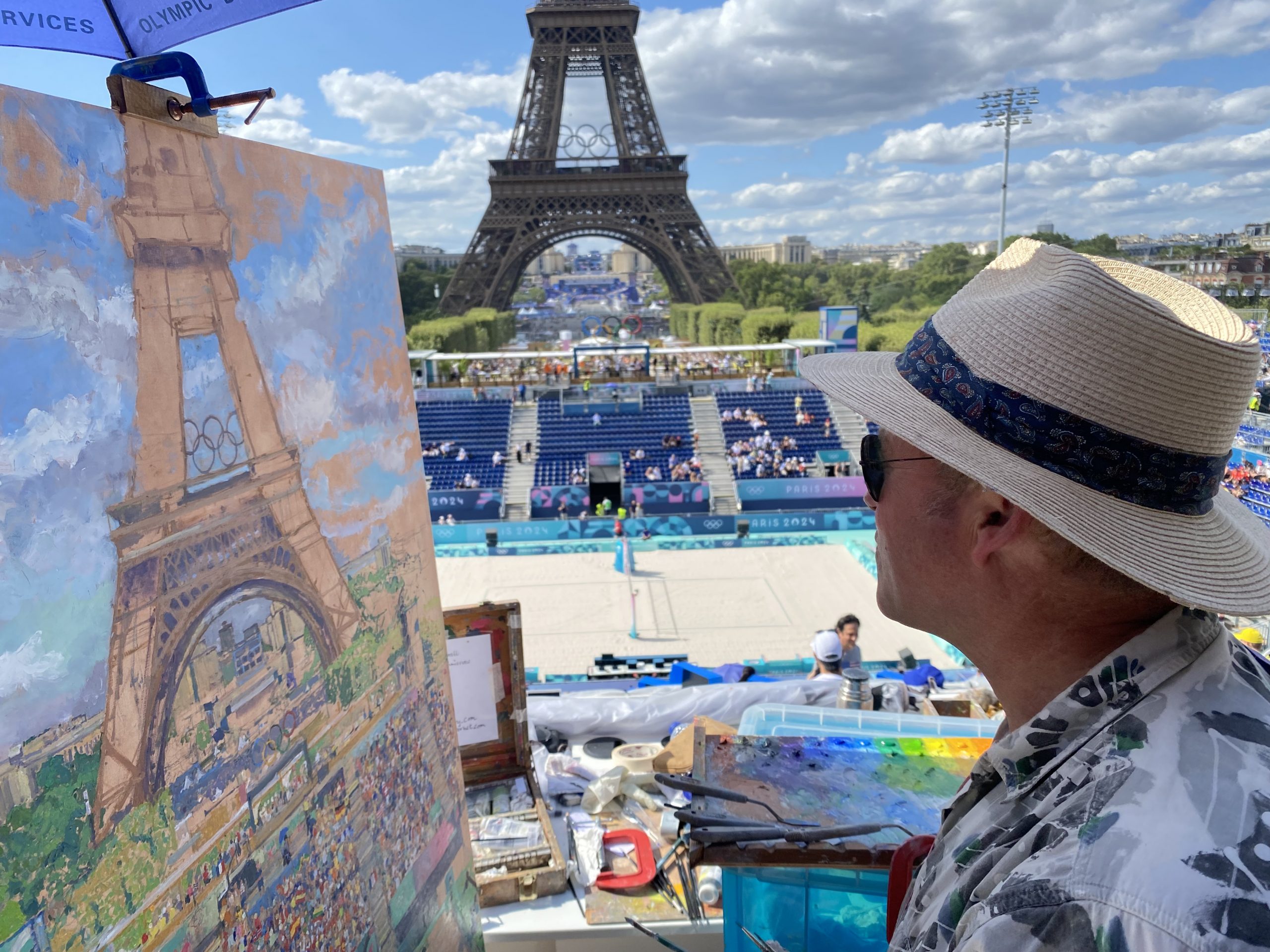
From the minute the first photos of the 2024 Summer Olympics started rolling in, it was clear that the city of Paris was providing a spectacular setting. There was the glowing cauldron rising above the Louvre’s glass pyramids, the dramatic fencing strip under the soaring steel and glass barrel-vaulted ceiling of the Grand Palais, and, beneath the Eiffel Tower, the sandy beach volleyball court where a jovial British man in a Panama hat stood at his easel, the official Olympic volleyball painter capturing the action with oil and brush.
That was 62-year-old London artist Peter Spens, providing one of the more unexpected and endearing moments of the games—and also documenting the competition’s volleyball tournament from the top row of the stands alongside the press photographers, but in a decidedly old-fashioned manner.
“The joke I made was I’m the Neanderthal working on this,” Spens told me.
It’s actually the artist’s third Olympics on the volleyball beat, after painting the action in London in 2012 and Rio in 2016.
Peter Spens painting the Olympic beach volleyball tournament, with a view of the Eiffel Tower.
He got involved with the games after a scouting party from the Olympic Broadcasting Services spotted him painting en plein air up on London’s Millbank Tower in 2011.
Although they had suggested Spens paint some of the action, he ultimately had to take matters into his own hands to arrange access. A friend connected Spens with a British Army officer, Lieutenant General George Norton, who came to visit the artist at his personal art gallery, Cranley Gallery.
“His mother had gone to the Slade,” Spens recalled. “He said, ‘I’m going to let you paint from our roof at Horse Guards, and I’d also suggest that you paint Trooping the Color, Beating Retreat, and the Thames [Diamond Jubilee] Pageant.’ When a two-star general says something in a very lovely, polite way, you say, ’Yep, that’s what I’m going to do.'”
Peter Spens’s painting of the 2012 Olympic beach volleyball tournament at the Horse Guards in London. Photo courtesy of the artist.
The Horse Guards is an 18th-century military barracks and stables that provided the perfect perch from which to observe those three important ceremonial events for the monarchy. It was also right above the beach volleyball venue constructed for the games on the Horse Guards Parade. Without meaning to, Spens—a landscape and cityscape specialist—was about to become the world’s preeminent beach volleyball artist.
When the games caught wind of the work Spens was making from his bird’s eye view, they invited him to paint inside the stadium, in the tunnel leading to the courts.
Four years later, he was back on the scene in Rio, this time courtesy of the International Volleyball Federation (FIV, for the Fédération Internationale de Volleyball, for short).
Peter Spens’s painting of the 2012 Olympic beach volleyball tournament at the Horse Guards in London. Photo courtesy of the artist.
The 2016 tournament was on sands of Copacabana Beach, with a gorgeous view of the ocean, and Spens did two paintings, capturing the scene both during the day and under the lights. (He remembers getting to bed at 2 a.m. after late night matches.)
Spens had to sit out the spectator-free Tokyo Olympics, but was excited to be back for Paris. He will be selling prints of his painting of the games, and FIV will give one to each of the medalists in both the men’s and women’s events. (David Åhman and Jonatan Hellvig of Sweden and Ana Patrícia and Duda Lisboa of Brazil took gold, respectively.)
Over his years as the official Olympic volleyball painter, the artist has developed a real love of the game.
Peter Spens’s painting of the 2016 Olympic beach volleyball tournament at Copacabana Beach in Rio. Photo courtesy of the artist.
“It’s a very exciting sport,” Spens said. “It’s got this sort of party atmosphere.”
Painting the Paris stadium was perhaps his biggest challenge to date, as he needed to capture not only the players and the stands, but the court’s dramatic backdrop: France built a stadium for the occasion on the Champ de Mars, the lawn at the foot of the Eiffel Tower, creating one of the most gorgeous vistas of the games.
Working in oil paint on board—easier to work with outdoors than canvas, which can billow in the wind—the artist captured the memorable scene.
Peter Spens’s nighttime painting of the 2016 Olympic beach volleyball tournament at Copacabana Beach in Rio. Photo courtesy of the artist.
“It’s a banded composition,” Spens said. “At the bottom, you’ve got the press and cameraman. Then you’ve got the field of play with the athletes and the line judges and the referees. The most complex band is that of the spectators, because there were just so many of them. And then there’s this view of Paris towards the Trocadero, and this central motif of the Eiffel Tower with this cloudscape behind. So, there’s a lot going on in that painting!”
To create the highly detailed work, Spens was on site for 10 to 14 hours every day during the two-week tournament. He even went back for one final session the day after the medals had been awarded.
Peter Spens’s completed painting of the Olympic beach volleyball tournament, with a view of the Eiffel Tower. Photo courtesy of Peter Spens.
“I was just desperate to finish it,” Spens admitted.
The days were long and the heat was intense, and Spens was exhausted by the time he flew back to London, painting safely packed away in a custom-designed box.
The finished work doesn’t so much represent a particular play in any specific match, but the tournament as a whole.
“What I’m doing really is a temporal collage,” Spens said, “based on individual moments of observation.”